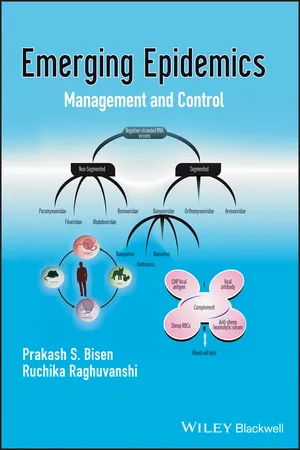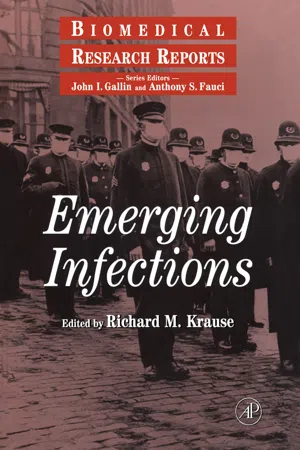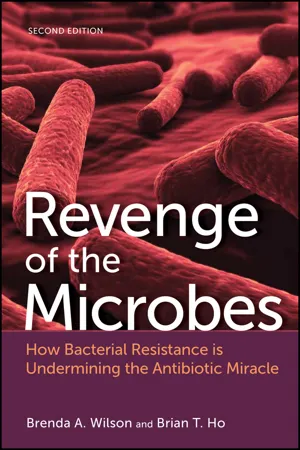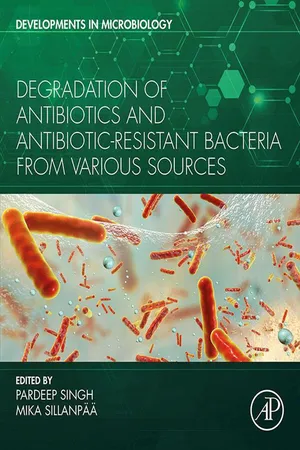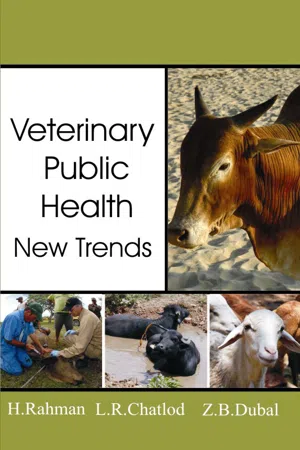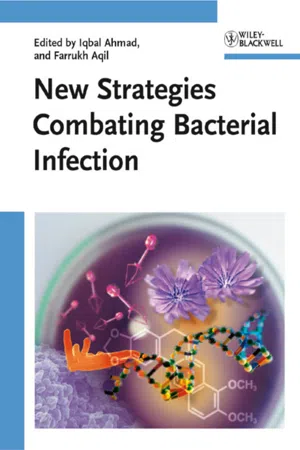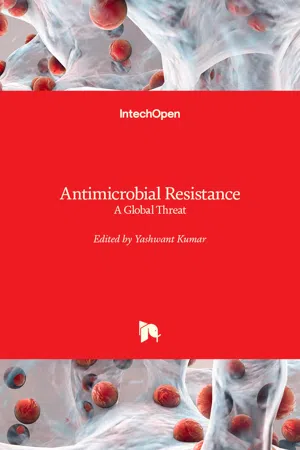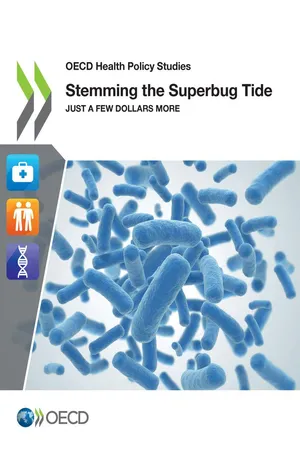Biological Sciences
Antibiotic Resistant Bacteria
Antibiotic resistant bacteria are strains of bacteria that have developed the ability to withstand the effects of antibiotics, making these medications ineffective in treating infections caused by these bacteria. This resistance can occur through genetic mutations or the acquisition of resistance genes from other bacteria. Antibiotic resistant bacteria pose a significant public health threat, as they can lead to more difficult-to-treat infections and increased healthcare costs.
Written by Perlego with AI-assistance
Related key terms
1 of 5
10 Key excerpts on "Antibiotic Resistant Bacteria"
- eBook - ePub
Emerging Epidemics
Management and Control
- Prakash S. Bisen, Ruchika Raghuvanshi(Authors)
- 2013(Publication Date)
- Wiley-Blackwell(Publisher)
Chapter 21
Antimicrobial Resistance
Introduction
Antibiotics have revolutionized how patients with bacterial infections are treated; they have further contributed to reducing the mortality and morbidity from bacterial diseases. They are also an essential tool for modern medicine and several surgical procedures, such as transplantation, chemotherapy for cancer, and even the orthopaedic surgery, could not be performed without the administration of potent antibiotics. Antibiotic resistance is currently the greatest challenge to the effective treatment of infectious diseases globally. It is a type of resistance in which a microorganism is able to survive exposure to a specific antibiotic. The drug resistance can be acquired by a spontaneous or induced genetic mutation in bacteria. Genes conferring drug resistance can be transferred between bacteria horizontally by any of the methods of genetic recombination, including conjugation, transduction, or transformation. Thereby, a gene for antibiotic resistance, which had evolved via natural selection, may be shared, and an evolutionary stress, such as exposure to antibiotics, then selects for the antibiotic resistant trait. Most of the antibiotic resistance genes reside on plasmids (an extra chromosomal material), facilitating their easy transfer. In case a bacterium carries several resistance genes against different antibiotics, it is called multidrug resistant (MDR), or informally, a superbug or superbacterium.Genes for resistance to antibiotic drugs, like the antibiotics themselves, are ancient (D’Costa et al., 2011). However, the increasing prevalence of drug-resistant bacterial infections commonly observed in clinical practice stems from antibiotic use both within human medicine and veterinary medicine. The use of antibiotics can increase selective pressure in a population of bacteria and allow the resistant bacteria to thrive and the susceptible bacteria to die off. As resistance toward antibiotics becomes more common, there arises a greater need for alternative treatments. However, despite a discovery of new antibiotic therapies, there has been a continued decline in the number of newly approved drugs (Donadio et al., 2010). Antibiotic resistance poses a significant problem, and it is also important to understand international patterns of resistance with globalization booming. The excessive use of antibiotics both inside and outside of medicine is playing a significant role in the emergence of resistant bacteria. Although initially there were few pre-existing antibiotic-resistant bacteria before the widespread use of antibiotics, evolutionary pressure from their use has played a role in the development of multidrug resistance varieties and the spread of resistance against more than one drug between bacterial species. - eBook - PDF
- John I. Gallin, Anthony S. Fauci(Authors)
- 1998(Publication Date)
- Academic Press(Publisher)
8 ANTIBIOTIC RESISTANCE IN BACTERIA JULIAN DAVIES and VERA WEBB Department of Microbiology and Immunology University of British Columbia Vancouver, British Columbia, Canada We must swim with the microbes and study their sur- vival and adaptation to new habitats. Richard M. Krause (1994) I. INTRODUCTION The development of antibiotic resistance can be viewed as a global problem in microbial genetic ecology. It is a very complex problem to contemplate, let alone solve, due to the geographic scale, the variety of environmental factors, and the enormous number and diversity of microbial participants. In addition, the situ- ation can only be viewed retrospectively, and what has been done was uncon- trolled and largely unrecorded. Simply put, since the introduction of antibiotics for the treatment of infectious diseases in the late 1940s, human and animal microbial ecology has been drastically disturbed. The response of microbes to the threat of extinction has been to find genetic and biochemical evolutionary routes that led to the development of resistance to every antimicrobial agent used. The result is a large pool of resistance determinants in the environment. The origins, evolution, and dissemination of these resistance genes is the subject of this review. II. MECHANISMS OF RESISTANCE: BIOCHEMISTRY AND GENETICS The use of antibiotics should have created a catastrophic situation for microbial populations; however, their genetic flexibility allowed bacteria to survive (and even thrive) in hostile environments. The alternatives for survival for threatened microbial populations were either mutation of target sites or acquisition of Emerging Infections Copyright © 1998 by Academic Press. All rights of reproduction in any form reserved. 239 - eBook - PDF
Revenge of the Microbes
How Bacterial Resistance is Undermining the Antibiotic Miracle
- Brenda A. Wilson, Brian T. Ho(Authors)
- 2023(Publication Date)
- ASM Press(Publisher)
27 Revenge of the Microbes: How Bacterial Resistance Is Undermining the Antibiotic Miracle, Second Edition. Brenda A. Wilson and Brian T. Ho. © 2023 American Society for Microbiology. The monumental advances in modern medicine made possible by antibiotics sparked an exciting new era of drug discovery. The race was on to expand our reper- toire of antibiotics capable of treating life-threatening infectious diseases. It was quickly discovered that many soil bacteria and fungi naturally produce compounds with antimicrobial properties, which prompted pharmaceutical companies to engage in large-scale screening efforts to find novel lead compounds that could be modified into effective antibiotics. Ultimately, for nearly 30 years after the discovery of penicil- lin, the market was continuously flooded with new antibiotics. As exciting as these new discoveries were, unfortunately, they ended up masking a growing problem: antibiotic resistance. Essentially, the deluge of new drugs meant that health care pro- viders were able to rely on there always being at least one antibiotic that could treat every infection, despite bacterial resistance to these drugs developing rather quickly. Only after new antibiotic discovery began to slow down did the rosy picture of anti- biotics completely solving all our infectious disease woes finally begin to crumble. ANTIBIOTIC RESISTANCE BECOMES A GROWING PROBLEM In the years immediately following the advent of antibiotics, academic researchers and some clinicians quickly began to notice that several clinically important bacteria had a high propensity to rapidly develop mechanisms for resisting the antibiotics used to treat them. In some cases, these bacteria would become resistant to a new antibiotic within just a few short years of the drug being first deployed (Table 3.1). Bacterial Resistance Threatens the Mighty Reign of Antibiotics 3 - Pardeep Singh, Mika Sillanpää, Pardeep Singh, Mika Sillanpää, Mika Silanpää(Authors)
- 2022(Publication Date)
- Academic Press(Publisher)
Chapter 4Current problems with the antibiotic-resistant bacteria and multiresistance bacteria
Xiumin Wang1 , 2 and Ting Li1 , 2 ,1 Institute of Feed Research, Chinese Academy of Agricultural Sciences, Beijing, P.R. China,2 Key Laboratory of Feed Biotechnology, Ministry of Agriculture and Rural Affairs, Beijing, P.R. ChinaAbstract
Antibiotics are the primary choice for treating bacterial infections, but overuse of antibiotics leads to the wide spread of bacterial resistance. Multiresistance bacteria have become a major global public health threat and are generally considered as emerging contaminants. Most people pay more attention to bacterial resistance, such as horizontal or vertical transfer of mobile genetic elements (including plasmids and transposons) that can be transferred autonomously between different bacterial species including probiotics. This review focuses on, the antibiotic resistance phenotypes, mechanisms, and detection methods of antibiotic resistance in bacteria. Influences on global health and the economic burden of bacterial resistance were also covered, as well as corresponding strategies in the battle against antibiotic resistance (dosage, combined formulation, surveillance, etc.). We hope that it can effectively reduce the adverse effects of antibiotic resistance, which also serves as the basis for further study, exploration and application of novel antibacterial agents.Keywords
Multiresistance bacteria; transfer; intrinsic antibiotic resistance; mechanism; acquired antibiotic resistance; strategy4.1 Introduction
The excessive use or misuse of antibiotics for animal and human diseases has caused the wide dissemination of bacterial resistance in the world (Wilson et al., 2002 ; Larsson and Flach, 2021 ). Bacterial antibiotic resistance happens when they develop the ability to resist the antibiotics that are used to kill them, which means that bacteria are not inhibited or killed by the same or similar antibiotics and they can continue to grow. Since the resistance to the first commercial penicillin in Staphylococcus aureus was found in 1942, the widespread acquisition of antibiotic resistance by various bacteria such as Salmonella , Escherichia coli , Shigella , and S. aureus was discovered in the 1950s and 1960s (Aslam et al., 2018 ; Rammelkamp, 1942 ). Over 80% of clinical S. aureus strains were resistant to penicillin in the late 1960s (Lowy, 2003 ). Bacterial antibiotic resistance inevitably emerged, almost concurrently with the clinical use of one new antibiotic (Levy, 1998 ). Hitherto, almost all known bacterial pathogens have developed resistance to antibiotics (Barber and Rozwadowska-dowzenko, 1948- eBook - PDF
Magic Bullets, Miracle Drugs, and Microbiologists
A History of the Microbiome and Metagenomics
- William C. Summers(Author)
- 2024(Publication Date)
- ASM Press(Publisher)
Detailed biochemical studies of the actions of antimicro- bials have led to the understanding of the many ways in which microbes evolve to become resistant to such agents. ANTIBIOTIC RESISTANCE IN THE CURRENT CONTEXT The successes of wonder drugs against infectious diseases in the 1950s and 1960s exposed several unanticipated circumstances. These were scientific, environmen- tal, and economic. First, the fact that many of the newly discovered antibiotics were “broad spectrum” led physicians to become casual about the need to iden- tify the particular offending pathogenic microbe and prescribe the appropriate therapy. The practice of identifying a pathogen by laboratory cultures followed by checking its sensitivity to a proposed therapy gave way in everyday practice to the “therapeutic trial” approach: treat with a broad spectrum antibiotic and if the patient is cured, the identification of the pathogen was of only “academic interest.” A corollary of this approach is that antibiotics became widely used for diseases that were not bacterial but viral in origin. The antibiotics in common use were known to be ineffective against viral diseases because viruses are of a totally dif- ferent biological realm. This practice inadvertently increased the antibiotic load in the biological environment leading to more unnecessary selective pressure on the normal microbial populations. Even if antibiotic resistance developed in innocu- ous bacteria, the phenomenon of lateral gene transfer meant that the resistance 42 • Magic Bullets, Miracle Drugs, and Microbiologists gene soon spread like a microbial epidemic into the more troublesome germs that would soon become a clinical problem. A phenomenon associated with casual antibiotic use had been foreseen by Ehrlich himself, the problem of insufficient dosages that then allowed for step-wise resistance to develop. - eBook - PDF
- Rahman, H(Authors)
- 2021(Publication Date)
- Biotech(Publisher)
Nonetheless, the ability of bacteria to acquire resistance genes from other organisms, including those that constitute the normal bacterial flora of humans, under the selective pressure of use of antibiotics should not be underestimated (Davies, 1994). SELECTIVE PRESSURE Selective pressure refers to the environmental conditions that enhance the ability of bacteria to develop resistance to antibiotics and to proliferate. This ability to survive may be the result of acquisition of new DNA (as is often the case with vancomycin resistant enterococci – VRE) or it may be due to spontaneous mutation, as is often the case for rifampin-resistant organisms. This ebook is exclusively for this university only. Cannot be resold/distributed. Expanded use of antibiotics in hospitals and in sites outside the hospital ( e.g. , long-term care facilities, day care centers, animal feedlots, and other agricultural sites) increases the selective pressure for resistant organisms to emerge in these settings. The intensity of use of antibiotics appears to be proportional to the resistance levels in organisms in hospital settings (Nicolle et al ., 1996, Dupont and Steele, 1987). MOLECULAR APPROACHES FOR STUDYING ANTIBIOTIC RESISTANCE The determination of antimicrobial susceptibility of a clinical isolate is often crucial for the optimal antimicrobial therapy of infected patients. This need is only increasing with increasing resistance and the emergence of multidrug-resistant microorganisms. Testing is required not only for therapy but also to monitor the spread of resistant organisms or resistance genes throughout the hospital and community (Fluit et al. , 2000a, Fluit et al ., 2000b, Fluit et al ., 2001). Nucleic acid-based detection systems offer rapid and sensitive methods to detect the presence of resistance genes and play a critical role in the elucidation of resistance mechanisms. - eBook - PDF
- Iqbal Ahmad, Farrukh Aqil(Authors)
- 2008(Publication Date)
- Wiley-Blackwell(Publisher)
This chapter will discuss recent strategies to obtain novel antibacterials from microbial products to combat drug-resistant bacteria. Further, roles of alternative therapy (phage therapy) and antibiotic use policy are discussed as possible ways to minimize the problem of drug resistant bacteria. 2.1 Introduction One of the greatest accomplishments of modern medicine had been the development of antimicrobial drugs for the treatment of infectious diseases. Alexander Fleming discovered the first antibiotic, penicillin, in 1928 and over half century of extensive research most acute bacterial infections had been treated effectively with antibacterial drugs. The remarkable success of antibacterial drugs had given an impression in the late 1960s and early 1970s that infectious diseases had been congruent. However, New Strategies Combating Bacterial Infection. Edited by Iqbal Ahmad and Farrukh Aqil Copyright Ó 2009 WILEY-VCH Verlag GmbH & Co. KGaA, Weinheim ISBN: 978-3-527-32206-0 j47 40 years later, infectious diseases still remain the third leading cause of death in the United States [1] and the second leading cause of death worldwide [2]. This is mainly due to the development of drug resistance, emergence of new infectious agents and nonavailability of suitable drugs for many infectious diseases. Indiscriminate and excessive use of antibiotics in medical as well as nonmedical settings has resulted in the selection and development of antibiotic resistance among clinical isolates. Bacterial pathogens have developed several mechanisms to overcome antibiotic pressure and now thrive even in the presence of multidrugs. Bacteria may develop resistance by mutation and by acquisition of new genes through bacterial genetic exchange mechanisms (conjugation, transformation and transduction). - eBook - PDF
Antibiotic Resistance
Origins, Evolution, Selection and Spread
- Derek J. Chadwick, Jamie A. Goode, Derek J. Chadwick, Jamie A. Goode(Authors)
- 2008(Publication Date)
- Wiley(Publisher)
In addition to morbidity and mortality caused by failure to cure those individuals who are infected by resistant pathogens, society as a whole must pay for the research and development of new antibiotics to keep pace with continually evolving pathogens. It is clear, therefore, that there are major costs associated with antibiotic resistance from the perspective of human society. But is there any cost associated with antibiotic resistance from the perspective of a bacterium? In an environment that contains antibiotic, possession of a corresponding resistance gene is clearly beneficial to a bacterium. However, in the absence of antibiotic, resistant genotypes may have growth rates that are lower than their sensitive counterparts. Mutations that confer resistance do so by disrupting some normal physiological process in the cell, thereby causing detrimental side-effects. In the case of plasmid- encoded resistance functions, bacteria must synthesize additional nucleic acids and 131 132 LENSKI proteins; this synthesis imposes an energetic burden (DaSilva & Bailey 1986) and the products that are synthesized may also interfere with the cell's physiology (Lenski & Nguyen 1988). Resistant bacteria may therefore be inferior competitors to sensitive genotypes in the absence of antibiotics. If so, then a possible strategy for containing the spread of antibiotic resistance would be to suspend the use of a particular antibiotic until the corresponding resistant genotypes had declined to low frequency. Figure 1 shows that the efficacy of this strategy depends on the cost of resistance from the perspective of the bacterium. Assuming that some sensitive genotypes have survived antibiotic treatment (or that they colonized after the treatment ended), the amount of time that would be required to reduce the abundance of resistant bacteria to a specified low level is inversely proportional to the cost of resistance. - eBook - PDF
Antimicrobial Resistance
A Global Threat
- Yashwant Kumar(Author)
- 2019(Publication Date)
- IntechOpen(Publisher)
Chapter 5 Development of Antibiotic Resistance in Wastewater Treatment Plants Fateme Barancheshme and Mariya Munir Additional information is available at the end of the chapter http://dx.doi.org/10.5772/intechopen.81538 Abstract Antibiotic Resistant Bacteria and antibiotic resistance genes have been of the emerg-ing contaminant threatening human health. The overuse of antibiotics, both in human patients and, importantly, in livestock, has led to an explosion of antibiotic-resistant bacteria, both in the U.S. and around the world. The prediction from the World Health Organization (WHO) is that, if nothing changes, the future will look a lot like the past— where people die from minor injuries that become infected. One of the goals should be a long-term sustainable balance with everything in our environment, including bacteria to promote human health. Different microbial techniques have been employed to study the occurrence and spread of antibiotic resistance in the environment, preventing us from returning to a pre-antibiotic era. Dissemination of antibiotic resistance genes to the environment is an important factor causing an increased prevalence of resistant patho-gens. Their spread to multidrug-resistant pathogens is one of the most emerging clinical challenges. Keywords: antibiotic resistant genes, Antibiotic Resistant Bacteria, wastewater, wastewater treatment plant, microbial pathogens 1. Introduction Antibiotics have been used broadly in the last decades for disease control as well as livestock breeding. The misuse and inappropriate disposal of antibiotics can develop antibiotic resis-tance bacteria (ARB) and multi-drug resistant bacteria which carry one or more antibiotic resistance genes (ARGs). In this century, ARB and ARGs are known as emerging pollutants that threaten food safety and public health [1 ]. Antibiotic resistance has been identified as © 2019 The Author(s). - eBook - PDF
- OECD(Author)
- 2018(Publication Date)
- OECD(Publisher)
The mixed policy approach would result in an average net reduction in health expenditure of around USD PPP 3 per capita per year. In practical terms, this would mean that millions of people in these countries would avoid AMR-related complications and health problems, with major 1. ANTIMICROBIAL RESISTANCE: A LARGE AND GROWING PROBLEM │ 37 STEMMING THE SUPERBUG TIDE © OECD 2018 potential gains for themselves in terms of their health well-being, for society and economic outcomes. Notes 1 The term “antimicrobials” refers to a broad family of agents including any agent killing or inhibiting the growth of microbes. There are many classes of antimicrobials depending on the type of microbes targeted or the composition of the antimicrobial. Antibiotics (or antibacterials) are a sub-category of antimicrobials specifically targeting bacteria. “Antimicrobial” is used in this chapter to specifically describe those agents that exert a killing function against bacterial pathogens, or agents that work as treatment or prophylaxis against bacterial infections. In most contexts of this chapter, antimalarial, antifungal and antiviral medicines are not included under the term “antimicrobials”. 2 Throughout this chapter, the name of the infectious microorganisms, rather than the name of the most common infections caused by such microorganisms, are used as virtually all the considered microorganisms can cause infections in many different organs. So, for example, Neisseria gonorrhoeae is used, rather than gonorrhea (which is commonly used to refer to the infections of the reproductive organs), as the same bacterium can also cause, among the others, infections of the musculoskeletal system (e.g. septic arthritis), of the gastrointestinal tract (e.g. pharynx and rectum), of the bloodstream, and other infections.
Index pages curate the most relevant extracts from our library of academic textbooks. They’ve been created using an in-house natural language model (NLM), each adding context and meaning to key research topics.
